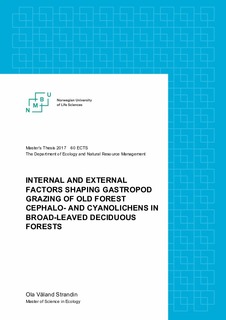| dc.description.abstract | Old forest lichens are used as indicators of continuity and biodiversity in forest ecosystems and are threatened by modern forestry practices. There is a need to better understand what internal and external factors affect their distribution and abundance. This thesis analyses grazing patterns and chemical defence compounds in various species in the old forest lichen genus Lobaria. First, in a field experiment, I examined how ecological factors in broadleaved deciduous forests shaped grazing and grazing preference by natural gastropods. The cephalolichen Lobaria pulmonaria and the cyanolichen L. scrobiculata were transplanted onto tree trunks of Quercus robur, Tilia cordata and Acer platanoides in an old-growth boreonemoral broadleaved deciduous forests at Language, Telemark, Norway for 75 days. Natural lichen grazing was quantified, ecological variables like pH of bark and soil, tree circumference, epiphyte cover etc. were measured in situ. Second, I quantified gastropod grazing using mixed populations of gastropods (Helicigona lapicida, Cepaea hortensis) in laboratory experiments on the cephalolichens L. pulmonaria and L. virens. In this second approach, the lichens had been preconditioned by a growth period of 27 days exposed to three different light/UV-B regimes and several growth variables were measured as part of the work of a previous master ́s student. Extractable secondary compounds were analysed from both experiments using high pressure liquid chromatography. In the field experiment Melanin content had no effect on controlled grazing by the gastropods Helicigona lapicida and Cepaea hortensis. Total CBSCs and lichen growth rates also had no effect on experimental grazing. The minor CBSCs methyl-norstictic and cryptostictic acids were found to decrease in concentration at higher relative thallus area growth rates, which suggests a trade-off between area growth and acid content. L. pulmonaria was consistently preferred over L. scrobiculata in the natural grazing experiment, which is the opposite of what had been observed in a previous study. Lichenivorous gastropods influence lichen- dominated epiphytic communities on tree trunks, but in more complex ways than was previously thought. | nb_NO |

